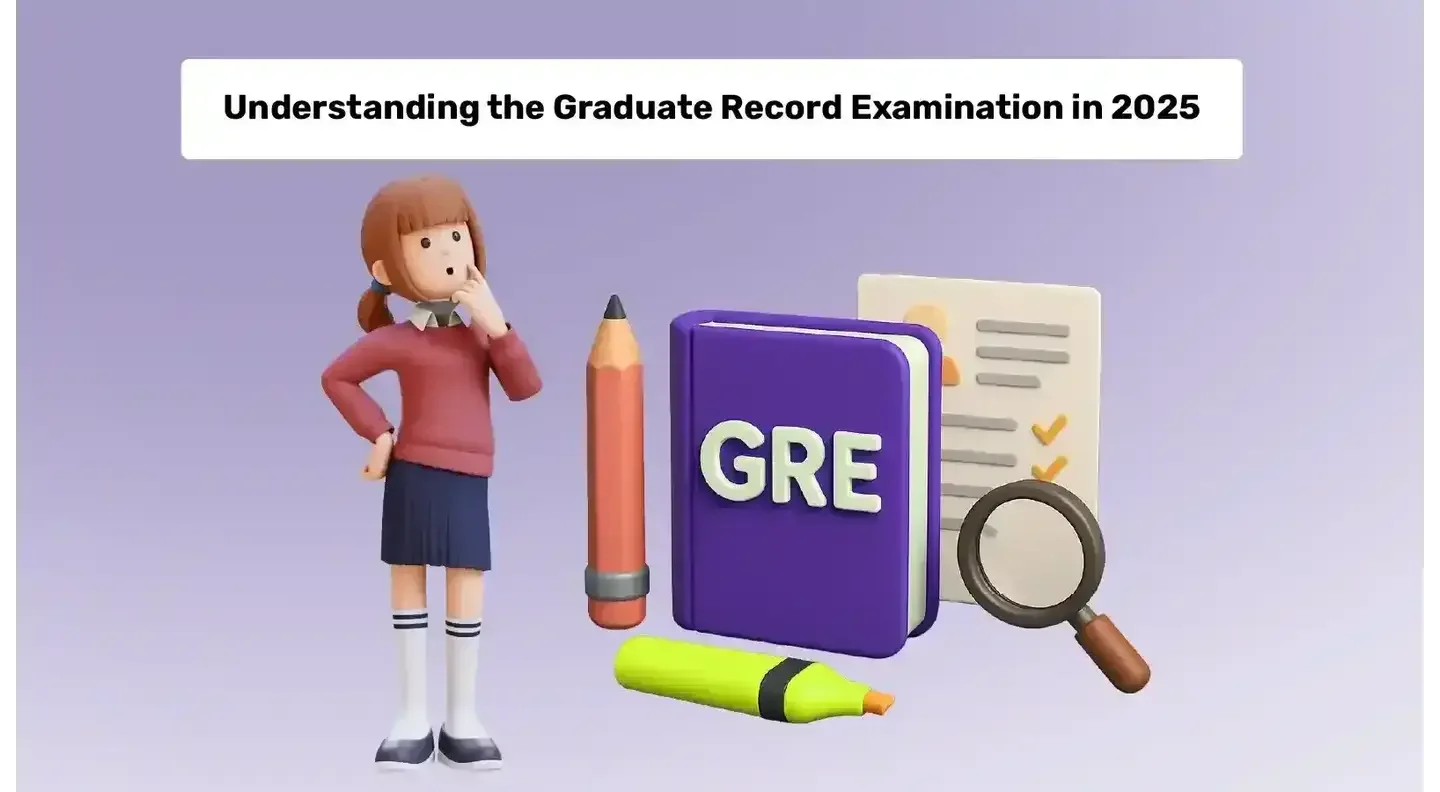Get instant loan offer suitable to your profile !


On this Page:
Thinking about pursuing your post-graduation from the US or the UK? Take a look at the basics of the GRE test based on the latest updates of 2025.
Thinking about pursuing a Master’s or a PhD abroad? You’ve likely come across the GRE. It is a highly competitive exam given by 6 to 7 lakh students every year. However, you don’t have to worry about that, we are here to guide you. In this blog, we are going to give you a basic understanding of the GRE.

The GRE (Graduate Record Examination) is a test required by universities at the time of admission to assess the academic capabilities of their applicants. This test is widely accepted in countries like the US, Canada, and Europe. The students who want to pursue their Master’s, MBA, and PhDs from these countries sit for this exam. The GRE tests your critical thinking, writing, and problem-solving skills. It is an adaptive test, meaning it will adjust its difficulty based on your current performance for the upcoming questions

The Educational Testing Service (ETS) administers the GRE. The test’s policies and guidelines are set by an autonomous GRE Board that is affiliated with the Association of Graduate Schools (AGS) and the Council of Graduate Schools (CGS). It is known for conducting exams fairly, with more than 40 test centres in India.

You can take the GRE all year-round at any time of the day via the at-home option. However, if you want to take the GRE at the centres, then the dates and timings may vary.
You can take the GRE General Test to secure your preferred date and location. It is recommended to register at least 3 to 4 months in advance. You can take the test once every 21 days, up to five times within any continuous rolling 12-month period.
The GRE General Test is available at numerous test centers across India. Here are some major cities with available centers:







The GRE test is of two types, the general test and the subject test. Each of these tests has a different purpose. It is important to know which test is to be given before submitting your college application. The table below gives a simplified view of their purposes:
| Test | Purpose |
|---|---|
|
GRE General Test |
Evaluates verbal, quantitative, and analytical writing skills. This is taken by most of the students as it assesses their overall academic skills. |
|
GRE Subject Tests |
Students applying for specialized Master’s or PhD programs. Available subjects: Mathematics, Physics, Psychology. |

Understanding the GRE structure is essential for effective preparation. It is important to be familiar with the time allotted for each section so that you can manage your pace effectively on test day. The table below mentions all three sections - analytical writing, verbal reasoning, and quantitative reasoning, along with the time allotted for each respective section.
| Section | Number of Questions | Time |
|---|---|---|
|
Analytical Writing (one task) |
1 essay task |
30 minutes |
|
Verbal Reasoning (two sections) |
|
|
|
Quantitative Reasoning (two sections) |
|
|
Total test time: 1 hour 58 minutes

Here’s a table outlining the GRE syllabus for the general test:
|
Section |
Subsection |
Content |
|
Analytical Writing |
Issue Task |
Write an essay on the given issue task. |
|
Argument Task |
Analyze the given task, and give factual and critical reasoning |
|
|
Verbal Reasoning |
Reading Comprehension |
Carefully read the passage and answer multiple-choice questions based on it. It tests your understanding, vocabulary, and ability to conclude. |
|
Text Completion |
You have to fill in the blanks according to the context and grammar of the sentence. |
|
|
Quantitative Reasoning |
Arithmetic |
Operations on integers, fractions, decimals, percentages, ratios, and proportions. |
|
Algebra |
Linear equations, quadratic equations, inequalities, and algebraic expressions. |
|
|
Geometry |
Properties and relations of geometric shapes, coordinate geometry, and basic geometric concepts. |
|
|
Data Analysis |
Interpretation of data, basic statistics (mean, median, standard deviation), probability, and data representation. |






A good GRE score depends on the programs you're applying to, but here’s a general guideline:



For top-tier universities, aim for a total GRE score (Verbal + Quantitative) of around 320+. However, highly competitive schools or programs may require scores closer to 330 or higher

Ideal GRE Scores for MS in Engineering for Top US Universities:
| Universities | Average Verbal Scores | Average Quantitative Scores | Total Score |
|---|---|---|---|
|
160 |
167 |
317 |
|
|
160 |
167 |
327 |
|
|
159 |
167 |
326 |
|
|
163 |
161 |
324 |
|
|
155 |
170 |
325 |
|
|
157 |
165 |
322 |
|
|
155 |
166 |
321 |
|
|
154 |
161 |
315 |
|
|
156 |
166 |
322 |
Top B-Schools and their GRE Score Criteria:
| Universities | Average Quantitative Reasoning Score | Average Verbal Reasoning Score | Average Total Score | Average Writing Score |
|---|---|---|---|---|
|
164 |
163 |
327 |
4.9 |
|
|
162 |
161 |
323 |
4.8 |
|
|
163 |
165 |
328 |
4.5 |
|
|
166 |
165 |
331 |
4.9 |
|
|
164 |
165 |
329 |
4 |
|
|
163 |
165 |
328 |
4.6 |
|
|
160 |
164 |
324 |
4.5 |
|
|
161 |
163 |
324 |
4.3 |
|
|
162 |
159 |
321 |
4.4 |
|
|
160 |
160 |
320 |
4.4 |
Please note that all GRE scores are approximate averages and may vary. For the most accurate information, please visit the official admissions websites.

In India, the GRE General Test fee is INR 22,000. If you need to reschedule or change centres, then you’ll have to pay a fee of INR 5,000. So, we suggest that you clear schedule for the day and avoid any unnecessary hassle.

Let’s face it, 2025 has made the GRE more flexible than ever, but that also means your decision needs to be more strategic. If you’ve got a strong profile, you might not need it. But if you're aiming high or feel certain areas of your application need a boost, a solid GRE score will tip the scales in your favor.
At the end of the day, it’s not just about the test, it's about the full story your application tells. So, whether you take the GRE or skip it, make sure that the story is strong, clear, and truly yours.

You'll receive your unofficial scores for Verbal and Quantitative Reasoning immediately after the test. Official scores are available within 8-10 days.
If you need to reschedule, ensure you do so at least 4 days before your test date to avoid additional fees.
No, it is not mandatory to take the GRE for all programs or universities abroad. Many universities have removed the GRE as a requirement for admission to their programs. Instead, you can focus more on your CGPA/ GPA, statement of purpose, letters of recommendation, relevant work experience, or research work, and English proficiency tests such as the IELTS/ TOEFL.
Your GRE score is valid for 5 years from the date you take your test. Moreover, if you have given the test consecutively, even then, all your scores are valid.
Check Your Education Loan Eligibility

Ask from a community of 10K+ peers, alumni and experts
Trending Blogs
Similar Blogs

Network with a community of curious students, just like you
Join our community to make connections, find answers and future roommates.. Join our CommunityCountry-Wise Loans
Best Lenders for Education Loan

ICICI Bank

Axis Bank

Union Bank

Prodigy

Auxilo

Credila

IDFC

InCred

MPower

Avanse

SBI

BOB

Poonawalla

Saraswat